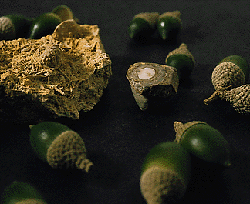
Photographer: ASU Research Magazine

Some people gaze out at the landscape and see plants. Professor Kathleen Pigg of Arizona State University sees the latest chapter in a long story.
Human beings weren't around for the early episodes in this long story starring plants. So Pigg studies fossilized plants to learn more about the plants that grow today. She can find out what happened to one type of plant during millions or even hundreds of millions of years.
Plants became fossilized in different ways. Pigg knows that water with minerals in it covered some plants in the Triassic, Eocene and other eras. Volcanic lava provided some of the minerals. The minerals hardened like rock around each plant cell so that the cell pattern was "petrified." Usually only a piece of the plant, such as a cone, leaf or stem, got petrified.
Pigg has traveled to many places to collect petrified plant parts. Back in her laboratory at ASU, she uses a rock saw to cut through the hardened minerals at different angles . Some pieces get cut into very thin slices, like a loaf of bread, and then examined under a microscope. Pigg uses a computer to take a picture of each thin slice, and the computer puts the pictures of the pieces together. She says it's like doing a CAT scan in a hospital because it lets her see in 3D.
Other people collect preserved plants to make jewelry. Petrified wood, like the wood from the Petrified Forest in Arizona, is often made into jewelry. Fossil resin known as amber is popular, too. Fossilized plants also can help large companies find oil and coal.
Pigg really likes to study the petrified plants that changed a lot in later years or that didn't survive. She likes to imagine what the plants were like when they lived. She knows that if she pays close attention, Mother Nature will explain what happened in the plant story.
The Geological Time Scale:
|
ERAS |
PERIODS | (and Epochs) | AGE (Beginning) |
| CENOZOIC | QUATERNARY | HOLOCENE | 10,000 years |
| PLEISTOCENE | 1.8 million years | ||
| NEOGENE | PLIOCENE | 5 million years | |
| MIOCENE | 24 million years | ||
| PALEOGENE | OLIGOCENE | 34 million years | |
| EOCENE | 55 million years | ||
| PALEOCENE | 65 million years | ||
| MESOZOIC | CRETACEOUS | 141 million years | |
| JURASSIC | 205 million years | ||
| TRIASSIC | 215 million years | ||
| PALEOZOIC | PERMIAN | 298 million years | |
| CARBONIFEROUS | 354 million years | ||
| DEVONIAN | 410 million years | ||
| SILURIAN | 434 million years | ||
| ORDOVICIAN | 490 million years | ||
| CAMBRIAN | 545 million years | ||
| PRECAMBRIAN | PROTEROZOIC | ~2500 million years | |
| ARCHAEOZOIC | ~4600 million years |
For further reading, Pigg recommends The Evolution of Plants and Flowers by BarryThomas (St. Martinàs Press: New York, 1991) or National Geographic magazine.
To view researchers at work in the field, click here.
Read more about: Getting to the Root of Plant Biology
Bibliographic details:
- Article: Getting to the Root of Plant Biology
- Author(s): Gail Maiorana
- Publisher: temp
- Site name: ASU - Ask A Biologist
- Date published:
- Date accessed:
- Link: https://askabiologist.asu.edu/explore/getting-root-plant-biology
APA Style
Gail Maiorana. (). Getting to the Root of Plant Biology. ASU - Ask A Biologist. Retrieved from https://askabiologist.asu.edu/explore/getting-root-plant-biology
Chicago Manual of Style
Gail Maiorana. "Getting to the Root of Plant Biology". ASU - Ask A Biologist. . https://askabiologist.asu.edu/explore/getting-root-plant-biology
Gail Maiorana. "Getting to the Root of Plant Biology". ASU - Ask A Biologist. . ASU - Ask A Biologist, Web. https://askabiologist.asu.edu/explore/getting-root-plant-biology
MLA 2017 Style

Kathleen Pigg with fossilized plant sample.
Be Part of
Ask A Biologist
By volunteering, or simply sending us feedback on the site. Scientists, teachers, writers, illustrators, and translators are all important to the program. If you are interested in helping with the website we have a Volunteers page to get the process started.
